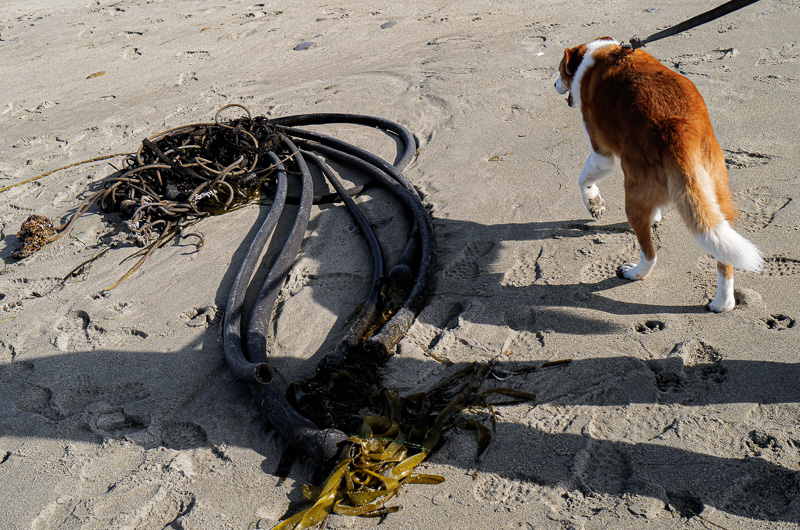I’m going to get into some deep philosophy today, relating to the fact that we don’t know how to create a mind, and we can’t really predict natural processes. And we never really will know. And it’s not because we’re not trying hard enough. It’s because of the nature of the world. There’s a basic principle at work, which I call Natural Undecidability.

More on this below, but to start with, I’ll have some stuff about what my family and I have been up to in this dear natural world.

And lately I took lots of photos with my new Leica Q2. Reviews say it’s a “point and shoot” but that’s not exactly true, to say that would be like saying a Fender Stratocaster is a ukelele. The Leica is like a piece of equipment left behind by a flying saucer. Day by day I’m figuring out more and more of the settings.
As usual, my photos don’t necessarily have any obvious connection with the text.

Our neighbors are building an extra dwelling right on the other side of the fence of the back yard, which is ny painting studio, and general hangout space. The Algerian ivy on the fence makes a pretty good privacy screen, but its heavy and the fence has been drooping. Son Rudy came down, and we put in five steel pipes to prop up our fence. A fun, sculptural activity. The temporary 2×4 props were to hold the fence back while the cement hardened in the metal pipes’ postholes. Surprise: a deer is in this shot.

Then our gang drove north to spend Thanksgiving with daughter Isabel in Fort Bragg, a few miles past Mendocino. Well out of the Bay Area bustle, which dies down after Petaluma. We stayed at the Beachcomber, a relatively inexpensive motel right on a cliff by the bluffs and the beach. Sunset in the photo above, with a low cloud/fog layer, and the sun just angling in through the slit. Obviuosly a UFO mothership. This was the view from our room.

Being 75, I’m thinking about mortality more and more these days. Forever trying to grasp the ancient riddle: “What is like to die?” Or to accept it, or come to term with it. Not that any of that makes a difference. It’ll come. I often list to myself my friends who’ve died. So strange.
Anyway, with that in mind, I noticed something about the ocean waves—I never get tired of watching the sea and pondering what I’m seeing. When a wave is just starting to break, a transparent lip of water curls over and reaches down to touch the face of the wave. the part I’m interested in just now is the few moments when the falling lip hasn’t yet touhed the body of the wave. Like what you see in the photo above.
And I formed the notion that the fleeting sheet of water was at some level a perfect metaphor for a full human life.

Back at home at my mad-scientist-type desk/laboratory, I described my insight to my writer Marc Laidlaw as follows.
Looking at the big waves breaking, so endlessly various and, at a more superficial level, the same. The ocean is vast and eternal, Syliva says the sea is a little scary as it’s so utterly indifferent. The ocean doesn’t care about the biggest storm, or how to move. The arriving water sloshes off the rocks and returns to the waaves.
I was focusing on the thing where a tube forms, often just a smallish teardrop-shaped-in-cross-section flap and not a full-on tunnel. I focus on the second when it hasn’t yet hit the face of the wave. This transient pompadour of water IS YOUR LIFE. Yes, that gnarly curved sheet, ridged-with flow-lines, edged-with-loplop-droopy-fronds, with drops flicking off, and light gleaming on it—IT’S YOU. You flow. You are flowing. That flap of water is your whole entire life. It lasts—from our point of view—only a second or two, but in and of itself it’s a complete life.
And then? It merges into the wave and dissolves into vortices and into a new, diffuse, order of being, with the old floppy teadrop-cross-section, striated, sun-gleamer gone. Over and over and over and over it happens. Nature never tires of repeating herself, but it isn’t really ever a REPEAT. Each of those water flaps, or lives, is solo unique entity—due to chaotic dynamics and due to the deep and essential unpredictability of naturally occuring universal computations.

Group mind. There were nine of us at Isbael and Gus’s loft, and we played some rounds of Banagrams. To finish one of the sessions, we did a group bananagram, not a contest, just a matter of playing all the letters, a group construction, a Poincare cross-section of the chaotic group mind.

While we were up there, Isabel lined up some heavy-duty old-fashioned redwood outrigger kayaks for us to paddle up the Big River at Mendocino. I rode with two of the grandchildren, and it was fun. Much more work than I’d expected. We’d imagined the incoming tide would carry us upstream, peak at the right moment and sweep us back down. Not exactly. Also my nine-year-old grandson perceived this as a race, and was contantly exhorting me to paddle faster. But it felt good. I was breathing really hard, and even grunting, and it was like I was exhaling some of the malaise that’s been dogging me of late.

“Mr. Gray” acrylic on canvas, 24″ x 18″, November, 2021. Click for a larger version of the painting.. More info on my Paintings page.
Let’s break for a painting that I finished a couple of weeks ago. Mr. Gray.
It’s a little like M. C. Escher’s images of tiled-together creatures. But I made this one more random and irregular. In grade-school we’d play a game of drawing a squiggly shape on a piece of notebook paper, and your fellow player would have to make it into an animal or a person. Really any shape at all can be a critter if you stare at it long enough. It’s just a matter of figuring out where to put the dot for the eye. The one human form is Mr. Gray himself. Maybe he’s having these colorful visions. I was also thinking of the Bob Dylan song “Idiot Wind” that opens with the line, “They say I shot a man named Gray and took his wife to Italy.” To me this line represents Dylan toppling the old regime and running off with the country’s youth. Taking them somewhere pleasant and colorful. And maybe becoming the new Mr. Gray.

And now let’s get down the deep philosophy I promised. The ignorabimus, which is a future-tense Latin verb meaning “we will not know.”
When we got home from our trip, my cyberpunk writer friend John Shirley alerted me to a news item about some scientists, one of them at Harvard, who made some artificial organisms that assemble copies of themselves, and naturally I’m, like, “I wrote about in Wetware. Meat boppers are real!” But some were saying, “This is the end, we’ve had it, Greg Bear’s gray goo is going to eat the world.”

But I don’t think we have to worry about artificial organisms eating the world anytime soon. After all (as I’ve said before) every single species has been trying, for millions of years, to totally dominate Earth, ceaselessly evolving and mutating and refining their wetware. And none of them ever wins. Because their rivals keep getting tougher. Kind of an intrinsic homeostasis, with the competing species keeping each other down.

If a little Harvard-built organism skips out into a rain-slick alley of our realtime cyberpunk future…it’ll be mugged by the skanky millennia-old critters seething around in the gutter, the OG germs of the natural funk.
An interesting point about this newly designed self-reproducing organism is they used a type of simulated evolution to design it. Computer scientists refer to this technique by the phrase “genetic algorithms.” You let a randomly generated population of algorithms compete with each other, and reproduce, and mutate, and recombine.

These days, any effective AI code arises by this type of evolution, which is also called deep learning.. Face recognition programs, or the pattern-recognition code that reads human handwriting—it’s all evolved. And nobody ever really “understands” the result. It’s incomprehensible. It’s a mound of a few thousand seemingly random decimal between 0 and 1. And these serve as weights for the links in a so-called neural network, which is designed by, as I say, an evolutionary process of genetic algorithms.
Back in the early days of AI, like the and 1950s and 1960s, zealots dreamt of finding a few simple rules about how minds work. And then (they imagined) bright MIT robots could march forth, utterly logical, well-programmed, gleaming with rationality. But this was a false dream. Indeed, when Kurt Godel proved his epic Incompleteness Theorem in 1931, he showed that it is even in principle impossible for us to describe human-equivalent code, and to describe it so clearly that it would be obvious that the code is correct and consistent.

Yes, due to profound and deep workings of logic, human-equivalent code must in fact be a fucked-up mess. Impossible to understand. No hope of proving it to be consistent. I wrote about all this in the “Towards Robot Consciousness” section of my nonfiction work, Infinity and the Mind. You can read it online.
In a prescient remark, Godel observed that nevertheless it would be possible for us to “bring such [human-equivalent] into existence.” And he was right. We do now in fact make computer code that’s smarter than expected. And, as I’m saying, we don’t do by deep insight. We do it by beating the problem to death with simulated evolution in an toy model of a world. What’s the expression? Nibbled to death by ducks.

Another science news item that got my attention of late is a new nonfiction book, A Natural History of the Future by Rob Dunn who argues that humans can’t fully comprehend the complexities of the natural world, or of evolution, let alone control them. (Full disclosure: It’s not like I actually read this book yet. I glanced at the description on the purchase page. But I certainly approve of it!)
It’s odd to me that even now, nearly a century after Godel, the average person keeps expecting that we’re going to get some simple final answers, and then begin controlling everything in sight. Hasn’t anyone been paying attention? For reasons related to Godel’s Incompleteness theorem, any hope of rational control over the world is dashed, just as was the hope finding a compact, crystalline secret-of-like-type design for an artificial human mind.

We can’t predict or control the natural world. About ten years ago I actually wrote up a formal proof for this, “An Incompleteness Theorem for the Natural World,” see details in this blog post. You could also call my result a proof of Natural Undecidability.
When I was in grad school at Rutgers, getting my Ph.D. in mathematical logic, I had a few golden hours of talking to Godel, I dreamed of writing an essay about the incompleteness of natural science, and then when I finally did, but somehow nobody but Stephen Wolfram cared. I’m not an officially licensed philosopher. And I have a peculiar talent for remaining obscure and underground,

My proof relates to Wolfram’s A New Kind of Science (NKS) and his “Principle of Equivalence.” He notes that natural processes can be thought of as gnarly natural computations: processes like flowing water, eddying air, flickering flames, growing organisms. And he posits that all gnarly computations are in fact equivalent to universal computations, capable of emulating any other system. And our man Alan Turing proved that the behavior of universal computations are, even in principle, unpredictable. Turing’s proof is similar to the proof of Godel’s Incompleteness Theorem. My full version is an anthology on Wolfram’s work, and in the “Random Truth” section of my tome, The Lifebox, the Seashell, and the Soul, available in ebook, print, and browsable online.

As with producing something akin to AI by means of long-drawn-out evolution of logical systems, we can to some extent predict nature by lengthy, time-consuming emulations, as is done by weather forecasters. But, and this is the key point, there is no quick-and-dirty way to predict nature. Just as there’s no simple golden rule for AI.

The unpredictability of nature relates not only to Godel and Turing’s work, but also to the mathematico-physical notion of chaos. The slightest difference in initial conditions leads to quite different outcomes. Making the point once again, natural processes do not allow prediction by simple formulae, but only by, at best, long emulations which inevitably deviate from the actual course of events..
“But what about quantum computation?” someone might say. “Once we get that working, we’ll have it sucked. We’ll be able to predict anything.”

Well, probably not. Sorry to be such a wet blanket! But, listen. We don’t know, and we never will. Ignorabimus. The best we can do is take pleasure in the state of not knowing. Keats wrote a famous letter mentioning “Negative Capability, that is, when a man is capable of being in uncertainties, mysteries, doubts, without any irritable reaching after fact and reason…”

A final note on the quantum computing thing, I wrote about it a little in my essay, “The Great Awakening.” Long story short, given that atoms function according to the laws of quantum mechanics, the natural world is in fact a quantum computation itself, and it’s not clear that we’d get any appreciable game-changing “leg up” on our predictive powers if we had tame quantum computations in our handy pocket flasks.
That that’s a fun thing to think about. Taking a nip off that quantum flask. SF! Chilly! Shivery! Brain freeze! And you’re like, “I see it all!”

But, d’oh, come to think of it, I actually already used this gimmick in my novel Mathematicians in Love, wherein the heroes are in fact able to predict the future by using some quantum-type gizmo.
Cryptomnesia strikes again! That’s when I think I’m having a new idea, but in fact it’s an idea I had a long time ago, an idea that I already wrote about at length. Where cryptomnesia gets pathological is if it’s someone else’s idea that you’re remembering, and you’re imagining you just discovered it.

But ideas aren’t everything. The harder part is coming up with the characters, language, plot, point of view, action, scenes, arcs, and publication possibilities. In Vergil’s words, loosely translated, “Ah, there is the bring-down, there is the drag.”
But writing fiction is doable. Even if we don’t know anything about anything. We know what it’s like to be human, and to be alive—and we know how to tell stories.









December 3rd, 2021 at 11:32 am
This particular column was like an illuminated scroll. It’s a tour de force effortlessly displaying your many gifts. Love the Mr Gray painting. Solid gnosis-reasoning (and intuiting) re the knowability and underlying nature of…nature. From a theological point of view it resonates, perhaps unwillingly with The Cloud of Unknowing, and the Upanishads, which declare the ineffable, the unknowable, as the name of the divine. Everything arises from chaos but every reaction-linkage making up a chaotic series is composed outwardly of Newtonian laws, which are innately orderly in themselves, and those laws are formed from substrates which result from quantum uncertainty. And it all adds up to, for example, the formation of planets, which are basically spheres, and orbits, which function with orderly repetitiveness, and biological systems. So it’s a chain of paradox. Uncertainty, to certainty, to random reactions, to order, which submits to entropy, breaks up–but according to law. Back and forth between chaos and tendencies toward orderliness; back to chaos. Paradox as a function; as building block. Meanwhile, the human mind can only express it, ontologically, in music; in symphony, or John Cage; in Chesley Bonestell or Pollack.
December 3rd, 2021 at 12:06 pm
Argh! Delete previous post. Retry:
You wrote:
I often list to myself my friends who’ve died. So strange.
Czeslaw Milosz wrote:
https://www.poetryfoundation.org/poems/49457/encounter-56d22b901521b
We were riding through frozen fields in a wagon at dawn.
A red wing rose in the darkness.
And suddenly a hare ran across the road.
One of us pointed to it with his hand.
That was long ago. Today neither of them is alive,
Not the hare, nor the man who made the gesture.
O my love, where are they, where are they going
The flash of a hand, streak of movement, rustle of pebbles.
I ask not out of sorrow, but in wonder.
December 3rd, 2021 at 12:38 pm
Escher once did an irregular tiling of creatures: “Mosaic II”. You can see it on page 61 of the hardbound edition of Hofstadter’s “Gödel, Escher, Bach”.
So your “Mr. Gray” is a rediscovery. Alas, the Master got there before you! But don’t worry about rediscovery, that’s how human culture works. It’s a parallel process, with massive redundancy built in, to ensure resilience. Here’s “Vemödalen”, from the “Dictionary of Obscure Sorrows”:
https://www.youtube.com/watch?v=8ftDjebw8aA
December 3rd, 2021 at 1:27 pm
Thanks, John! You’re the one who got me started on this thread, so thanks for that.Not everyone will know that you and I wrote a great story called “Pockets” some years ago. It’s online here
http://www.rudyrucker.com/transrealbooks/completestories/#_Toc39
December 3rd, 2021 at 6:25 pm
You’re my favorite writer, Rudy <3
Thanks for everything, I think about your stuff almost daily.
Now I learned a new word (cryptomnesia), I get it all the time and I'm like 30.
Always wanted to ask you, are there any plans for a ware tetralogy movie?
December 4th, 2021 at 12:47 pm
Re: rehashing old ideas, I’ve become a bit of a pattern Darwinist lately. If books don’t get reprinted, they eventually just disappear. All of my music and vidya games I’ve written will disappear shortly after i stop copying them.
Partially, that’s okay: a lot of unfit songs will just vanish.
Partially, it shows me that copying and rehashing aren’t necessarily evil as I thought when i was younger and hadn’t yet seen anything disappear.
January 3rd, 2022 at 10:50 am
Beautiful.